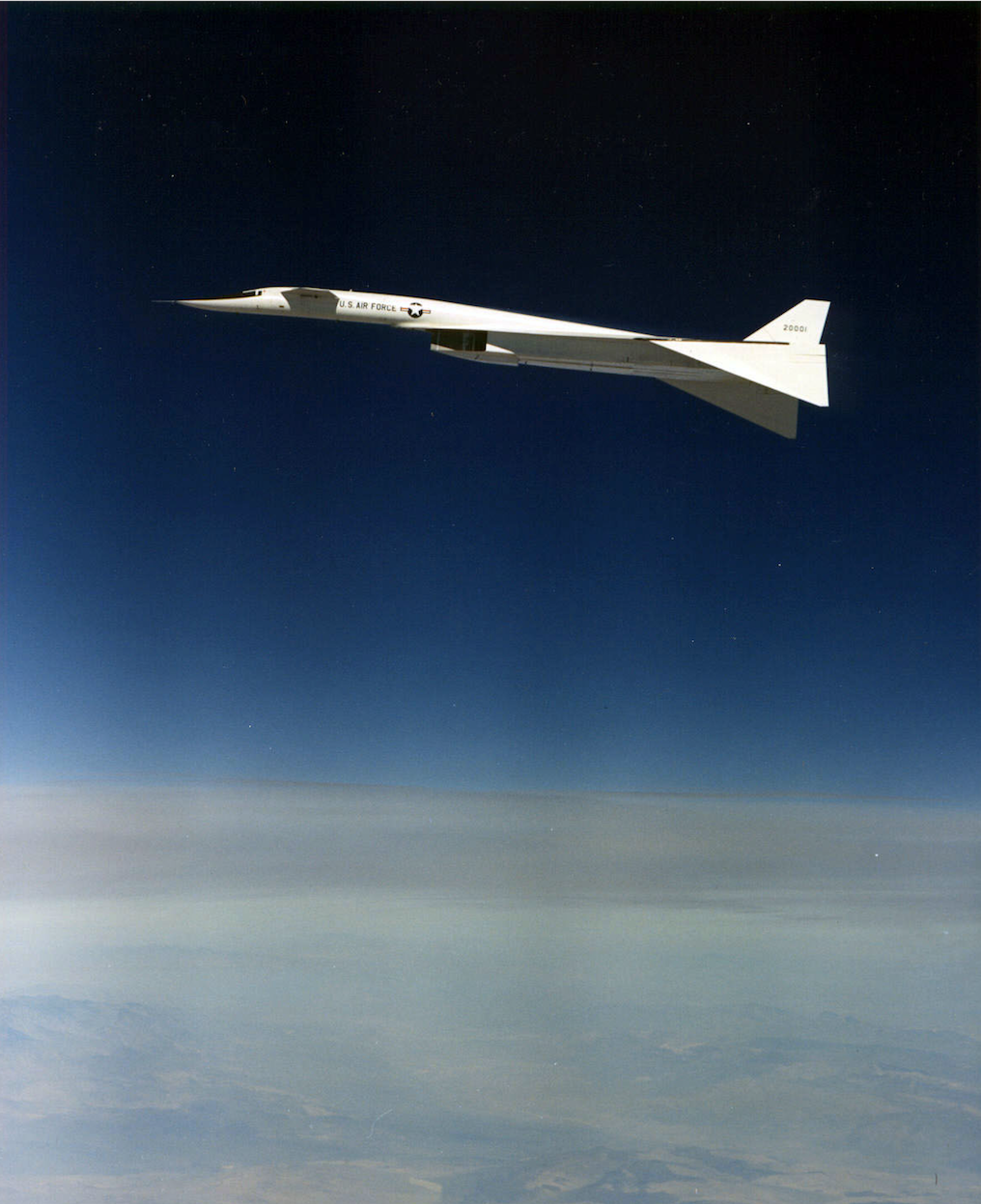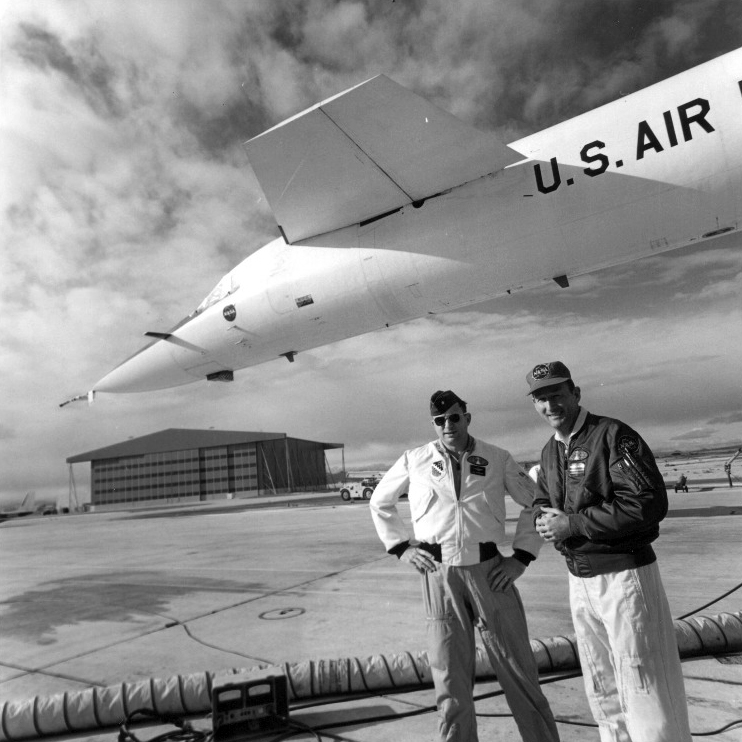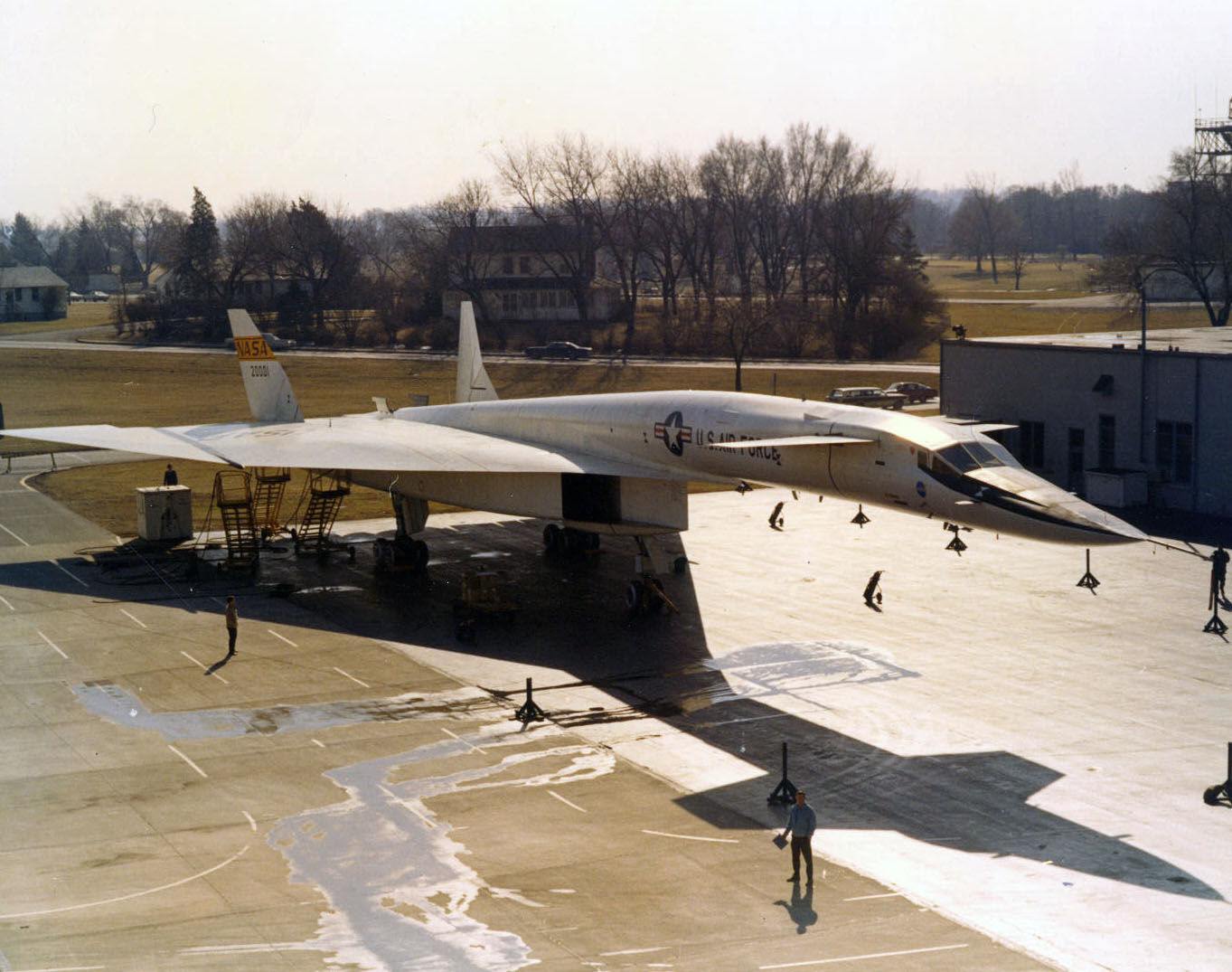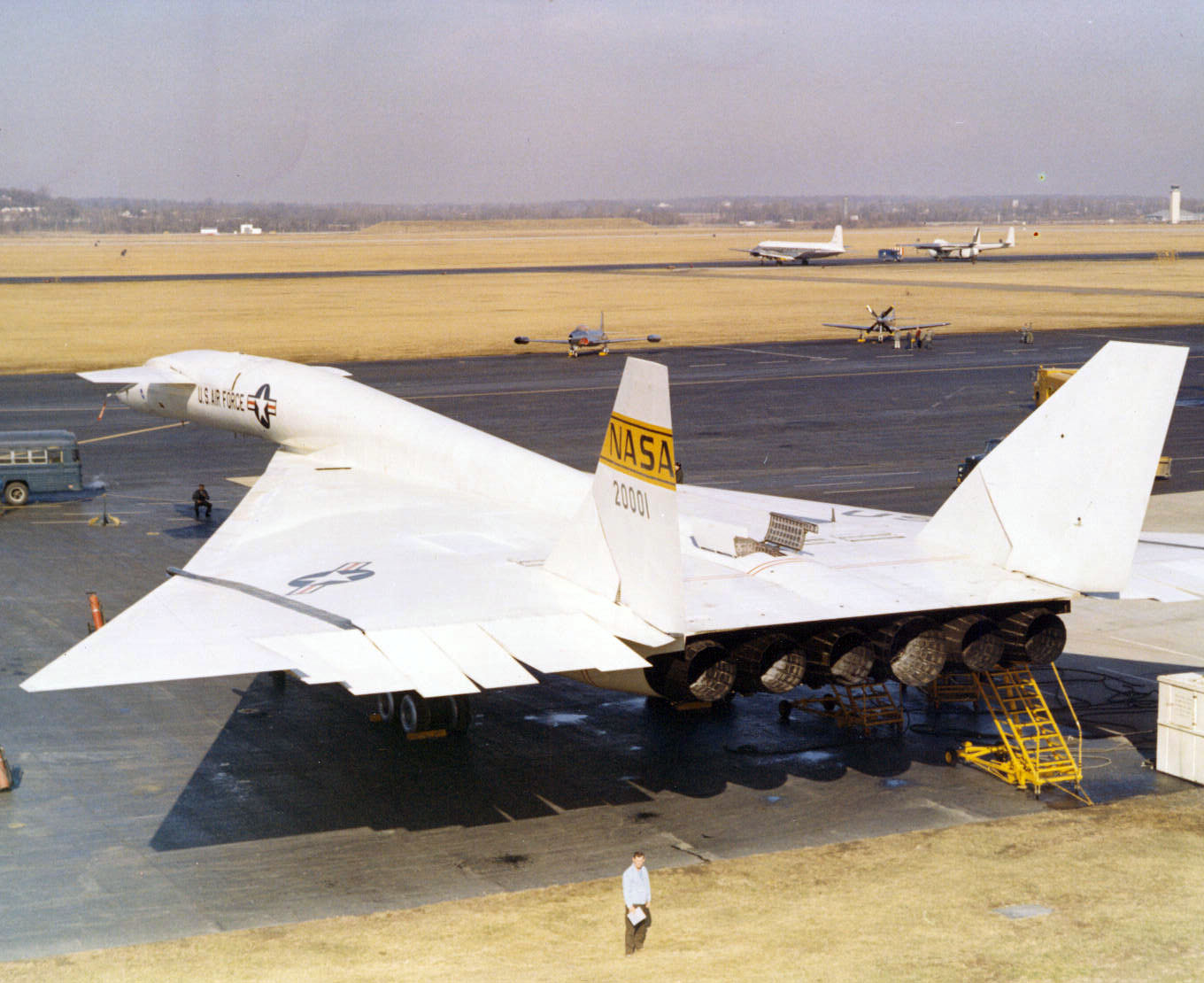
4 February 1969: The North American Aviation XB-70A-1-NA Valkyrie, 62-0001, made its very last flight from Edwards Air Force Base, California, to Wright-Patterson Air Force Base, Ohio. NASA Research Test Pilot Fitzhugh L. Fulton, Jr., Lieutenant Colonel, U.S. Air Force (Retired), and Lieutenant Colonel Emil Sturmthal, U.S. Air Force, were the flight crew for this final flight.
On arrival at Wright-Patterson, Fulton closed out the log book and handed it over to the curator of the National Museum of the United States Air Force.
The Mach 3+ prototype strategic bomber and high-speed, high-altitude research airplane made its first flight 21 September 1964. It completed 83 flights for a total of 160 hours, 16 minutes of flight time.

 62-0001 was the first of three prototype Mach 3+ strategic bombers. (The third prototype, XB-70B 62-0208, was not completed.) The Valkyrie utilized the most advanced technology available. Materials and manufacturing techniques had to be developed specifically to build this airplane. It is a large delta wing airplane with a forward canard and two vertical fins. The outer 20 feet (6.096 meters) of each wing could be lowered to a 25° or 65° angle for high speed flight. Although this did provide additional directional stability, it actually helped increase the compression lift, which supported up to 35% of the airplane’s weight in flight.
62-0001 was the first of three prototype Mach 3+ strategic bombers. (The third prototype, XB-70B 62-0208, was not completed.) The Valkyrie utilized the most advanced technology available. Materials and manufacturing techniques had to be developed specifically to build this airplane. It is a large delta wing airplane with a forward canard and two vertical fins. The outer 20 feet (6.096 meters) of each wing could be lowered to a 25° or 65° angle for high speed flight. Although this did provide additional directional stability, it actually helped increase the compression lift, which supported up to 35% of the airplane’s weight in flight.
The XB-70A is 185 feet, 10 inches (56.642 meters) long with a wingspan of 105 feet (32.004 meters) and overall height of 30 feet, 9 inches (9.373 meters). The delta wing had 0° angle of incidence and 0° dihedral. (The second XB-70A had 5° dihedral.) The wing has 3.0° negative twist. At 25% chord, the wing has 58.0° sweepback. Total wing area is 6,297 square feet (585 square meters). The Valkyrie has a empty weight of 231,215 pounds (104,877 kilograms), and maximum takeoff weight (MTOW) of 521,056 pounds (236,347 kilograms).
 It is powered by six General Electric YJ93-GE-3 turbojet engines. The J93 is an afterburning single-shaft axial-flow turbojet with an 11-stage compressor section and two-stage turbine. It has a Normal Power rating of 17,700 pounds of thrust (78.73 kilonewtons), 19,900 pounds (88.52 kilonewtons), Military, and 28,000 pounds (124.55 kilonewtons) Maximum. (All ratings are continuous, at 6,825 r.p.m.) The YJ93-GE-3 is 236.3 inches (6.002 meters) long, 54.15 inches (1.375 meters) in diameter, and weighs 5,220 pounds (2,368 kilograms).
It is powered by six General Electric YJ93-GE-3 turbojet engines. The J93 is an afterburning single-shaft axial-flow turbojet with an 11-stage compressor section and two-stage turbine. It has a Normal Power rating of 17,700 pounds of thrust (78.73 kilonewtons), 19,900 pounds (88.52 kilonewtons), Military, and 28,000 pounds (124.55 kilonewtons) Maximum. (All ratings are continuous, at 6,825 r.p.m.) The YJ93-GE-3 is 236.3 inches (6.002 meters) long, 54.15 inches (1.375 meters) in diameter, and weighs 5,220 pounds (2,368 kilograms).
The maximum speed achieved was Mach 3.1 (1,787 knots/2,056 miles per hour, or 3,309 kilometers per hour) at 73,000 feet (22,250 meters). Its mission maximum speed is 1,721 knots (1,980 miles per hour/3,187 kilometers per hour) at 79,050 feet (29,094 meters). The XB-70A has a rate of climb of 33,000 feet per minute (168 meters per second). The service ceiling is 79,000 feet (24,079 meters).
The Valkyrie has a maximum fuel capacity of 43,646 gallons (165,218 liters) JP-5 or JP-6, carried in 11 tanks throughout the fuselage and wings. It also carries 42.4 gallons (161 liters) of engine oil. The maximum range is 2,969 nautical miles (3,417 statute miles/5,499 kilometers).
The second Valkyrie, XB-70A-2-NA 62-0207, was destroyed when it crashed after a mid-air collision with a Lockheed F-104N Starfighter flown by NASA Chief Research Test Pilot Joseph A. Walker, 8 June 1966. Both Walker and the B-70’s co-pilot, Major Carl S. Cross, U.S. Air Force, were killed.
XB-70A Valkyrie 62-0001 is in the collection of the National Museum of the United States Air Force.


© 2024, Bryan R. Swopes
You do a great job with this blog and I really enjoy and look forward to reading it each day.
(I built a model of the Valkyrie when I was a kid. Someday I’m going to go to Dayton and see the real thing.)
Tony
Thank you, Anthony. I recall building the Aurora B-70 kit in the early ’60s. NMUSAF has recently moved the Valkyrie into their newly-completed fourth building. I would guess that one could spend DAYS there, checking out all the exhibits.
Thank you for the photos of her arrival at W-PAFB and the NMUSAF. I had not seen those before. The Valkyrie is a beautiful airplane! I live near Dayton and love to get out to the museum whenever I can (which is not nearly often enough!). Thank you for this wonderful blog! Keep up the good work!
Thank you, Jenny. I had seen a b&w news photo of the XB-70 on very short final to the runway at W-P, but have not succeeded in finding it on the Internet, though not for lack of trying. :/ Thank you for being such a regular reader of TDiA. —Bryan
Did engineering drawings of the 8- engine ADS bays for all three air vehicles at the original NAA wind tunnel building that was on Imperial Blvd at the Los Angeles airport (LAX) El Segundo. Went through these vehicles by flying on the NAA company DC-3 (yes…a DC-3) to the Palmdale Mohave desert build facility to checkout the assemblies. A great memory and a lot of satisfaction on contributing to the XB-70 effort. A fantastic aircraft made from stainless steel honeycomb. One of the main highlights to my 62 engineering career, which also included our space shuttle development, and moon exploration hardware.
One remaining wish would be for something of that greatness for our young engineers of today to get involved with. It keeps you focused. What got me interested in aircraft / aerospace engineering ?………….being able to walk through the Hughes Spruce Goose flying boat at the age of 10 years while it was being built.
Thank you, Richard. The B-70 has always been a favorite.
The Air Force museum has a magnificent collection, but if there’s one star, it’s the Valkyrie. They may have a plane that dropped an atomic bomb in combat and the president’s personal transport, but only one plane has a cafe named after it.
https://www.afmuseum.com/dining
I was at Edwards AFB, Feb 69-Sep 70, assigned to the 6510SP Sqdn, and worked Pass and ID. One afternoon, a Lt Col came in to get his retirement ID card. Come to find out he was LtCol Joe Cotton test pilot of the XB 70. I got to talk to him a bit, issued his ID card, and before he left he said his wife and daughters would be coming in later to get the IDs done. Later that afternoon his wife and daughters came in and I issued their IDs. Looking over the application I noticed their youngest daughters name – on the application was typed: COTTON Candy. Col Cotton took early retirement due to the 1st XB70 crash, he was flying one of the chase planes, the other got caught up in the exhaust vortex and tumbled across the XB70 causing both aircraft to crash.
Thanks for a superb post on this legendary aircraft.
I built the 1/72 kit when I was a teen, and then built another one 10 years ago, well into my fifties … There is an awesome book on the B70 by John M Campbell with nothing but color shots, some showing both B70’s on the same shot.
Bryan – New to your site and really enjoy your work. A great daily stop for me. Keep up the good work. Thanks, JEFF
Thank you very much, Jeff. I am happy to have you join us. 🙂